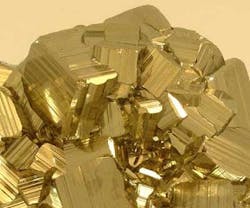Pyrite leads OSU researchers to new, inexpensive photovoltaic materials
Pyrite (Image: OSU)
Corvallis, OR--Researchers at the Center for Inverse Design at Oregon State University (OSU) have determined that some chemical compounds similar to pyrite (also known as "fool's gold") look promising for use in photovoltaic (PV) cells.1 The Center for Inverse Design is a collaborative initiative of the College of Science and the College of Engineering at OSU, formed two years ago with a $3 million grant from the U.S. Department of Energy. It was one of the new Energy Frontier Research Centers set up through a national, $777 million federal program to identify energy solutions for the future.
Pyrite, or iron sulfide (FeS2), by itself has little value as a future PV compound, the scientists say. But it's been known for more than 25 years as having some desirable qualities that made it of interest for solar energy. “We’ve known for a long time that pyrite was interesting for its solar properties, but that it didn’t actually work,” said Douglas Keszler one of the researchers. “We didn’t really know why, so we decided to take another look at it."
Pyrite was of interest early in the solar-energy era because it is an effective solar absorber, even in very thin films, when layered on top of a PV material. However, by itself it didn't convert solar energy into electricity. In the new study, the researchers found out why. In the process of creating solar cells, which takes a substantial amount of heat, pyrite starts to decompose and forms products that prevent the creation of electricity.However, a similar compound, iron silicon sulfide, does not have this problem.
“Iron is about the cheapest element in the world to extract from nature, silicon is second, and sulfur is virtually free,” Keszler said. “These compounds would be stable, safe, and would not decompose. There’s nothing here that looks like a show-stopper in the creation of a new class of solar-energy materials.”
REFERENCE:
1. Liping Yu et al., Advanced Energy Materials (2011); DOI: 10.1002/aenm.201100351
